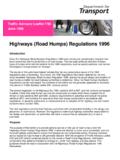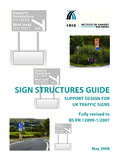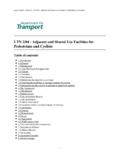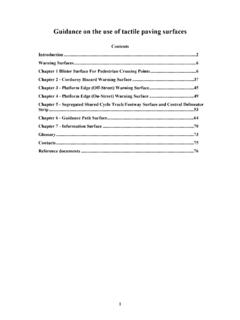Transcription of DMRB VOLUME 7 SECTION 3 PART 1 - HD 28/04 - SKID …
1 August 2004 DESIGN MANUAL FOR ROADS AND BRIDGESVOLUME 7 PAVEMENT DESIGN ANDMAINTENANCESECTION 3 PAVEMENTMAINTENANCEASSESSMENTPART 1HD 28/04 SKID RESISTANCESUMMARYThis Standard describes how the provision ofappropriate levels of skid resistance for trunk roads willbe managed. It details how measurements of skidresistance are to be made and interpreted and iscomplemented by HD 36 ( dmrb ), which sets outadvice on surfacing material characteristics. This latestrevision has changed requirements for settinginvestigatory levels, for annual SCRIM surveys, fordetermining the characteristic SCRIM coefficient andhas further updates in line with current FOR USEThis revised Standard is to be incorporated in document supersedes HD 28/94, which isnow existing Contents page for VOLUME 7 andinsert new Contents page for VOLUME 7 datedAugust HD 28/94, which is superseded byHD 28/04 , and archive as HD 28/04 in VOLUME 7, SECTION 3, Part archive this sheet as : A quarterly index with a full set of VolumeContents Pages is available separately from TheStationery Office Ltd.
2 HD 28/04 Skid ResistanceSummary:This Standard describes how the provision of appropriate levels of skidresistance for trunk roads will be managed. It details how measurements of skidresistance are to be made and interpreted and is complemented by HD 36( dmrb ), which sets out advice on surfacing material characteristics. Thislatest revision has changed requirements for setting investigatory levels, forannual SCRIM surveys, for determining the characteristic SCRIM coefficientand has further updates in line with current MANUAL FOR ROADS AND BRIDGESTHE HIGHWAYS AGENCYSCOTTISH EXECUTIVEWELSH ASSEMBLY GOVERNMENTLLYWODRAETH CYNULLIAD CYMRUTHE DEPARTMENT FOR REGIONAL DEVELOPMENTNORTHERN IRELANDV olume 7 SECTION 3 Part 1 HD 28/04 August 2004 REGISTRATION OF AMENDMENTSA mendPage NoSignature & Date ofAmendPage NoSignature & Date ofNoincorporation ofNoincorporation ofamendmentsamendmentsRegistration of AmendmentsVolume 7 SECTION 3 Part 1 HD 28/04 August 2004 REGISTRATION OF AMENDMENTSA mendPage NoSignature & Date ofAmendPage NoSignature & Date ofNoincorporation ofNoincorporation ofamendmentsamendmentsRegistration of AmendmentsVOLUME 7 PAVEMENT DESIGN ANDMAINTENANCESECTION 3 PAVEMENTMAINTENANCEASSESSMENTPART 1HD 28/04 SKID of Skid the Investigatory of of Warning 1 Background Information on theMeasurement and Interpretation of SkidResistanceAnnex
3 2 SCRIM Survey of Operational ProceduresAnnex 3 Processing and Computation ofCharacteristic SCRIM CoefficientAnnex 4 Site InvestigationAnnex 5 Assessment of Accident DataAnnex 6 Use of Different Types of Test in AccidentInvestigationDESIGN MANUAL FOR ROADS AND BRIDGESA ugust 2004 VOLUME 7 SECTION 3 Part 1 HD 28/04 August 20041/1 Chapter 1 Introduction1. purpose of this document is to describe howthe provision of appropriate levels of skid resistance onin-service UK Trunk Roads, motorways and all-purpose trunk roads, will be managed. This documentdescribes how measurements of skid resistance are tobe made and interpreted and is complemented byHD 36 ( dmrb ), which sets out advice onsurfacing material characteristics necessary to deliverthe required skid resistance this document, the term skid resistance refers to the frictional properties of the road surfacemeasured using a specified device under standardisedconditions. The term always refers to measurementsmade on wet roads, unless specifically stated measurements are used to characterise theroad surface and assess the need for maintenance,but cannot be related directly to the frictionavailable to a road user making a particularmanoeuvre at a particular skid resistance of a wet or damp road surfacecan be substantially lower than the same surface whendry, and is more dependent on the condition of thesurfacing material.
4 The objective of this Standard is tomanage the risk of skidding accidents in wet conditionsso that this risk is broadly equalised across the trunkroad network. This is achieved by providing a level ofskid resistance that is appropriate to the nature of theroad environment at each location on the network. Theappropriate level of skid resistance is determined from anetwork accident analysis plus local judgement of site-specific this Standard, the provision of appropriatelevels of skid resistance is treated primarily as an assetmanagement issue rather than one of road safetyengineering, although the accident risk is assessed inorder to determine an appropriate level of skidresistance for each site. Specifically, this Standard doesnot address the identification of locations or routeswhere road safety engineering measures could bebeneficial to reduce Standard provides advice and guidance toassist the engineer in determining an appropriate levelof skid resistance for each site.
5 It lays down theprocedure to be used for measuring the skid resistanceand, for cases where the measured skid resistance is ator below a predetermined level, it provides amethodology to assist the engineer in assessing therequirement and priority for remedial works. Remedialworks will be subject to an economic assessment of thecosts and benefits before proceeding, to promote thebest use of maintenance 2 summarises the operation of the skidresistance Standard. Chapters 3 to 7 describe keycomponents of the Standard: the measurement of skidresistance, the process of setting Investigatory Levels,site investigation, the prioritisation of treatments anduse of warning signs. These chapters are supported by anumber of Annexes that give more detailed instructionsor 1 provides background informationrelevant to the measurement and interpretation of skidresistance. Annex 2 gives operational details formeasuring skid resistance and Annex 3 gives themethods for processing the raw survey data to derivevalues that characterise the skid 4 and Annex 5 describe methodologies forsite investigation and for assessing accident 6 discusses the different test methods usedin accident investigation.
6 Police collision investigatorsuse physical evidence ( marks on the road surface)and skid tests at accident sites to estimate the approachspeed of vehicle(s) involved and its relevance to roadsurface condition. In giving evidence in court, policeofficers have, on occasion, used the results of skid tests,often made in dry conditions, to comment on theadequacy or otherwise of the skid resistance of the roadsurface. This has, on occasion, led to claimants usingpolice evidence to try to demonstrate that a road surfacewas unsatisfactory, even though the purpose of theirtests are quite separate from skid resistance tests toassess the surface condition, as explained in Annex This Standard shall be used forthwith on allschemes for the construction, improvement andVolume 7 SECTION 3 Part 1 HD 28/04 August 20041/2 Chapter 1 Introductionmaintenance of trunk roads including motorways,currently being prepared provided that, in the opinionof the Overseeing Organisation this would not result insignificant additional expense or delay.
7 Designorganisations should confirm its application toparticular schemes with the Overseeing The construction and maintenance of highwaypavements will normally be carried out under contractsincorporating the Overseeing Organisation sSpecification for Highway Works (MCHW1). In suchcases products conforming to equivalent standards andspecifications of other member states of the EuropeanUnion and tests undertaken in other member states willbe acceptable in accordance with the terms of the 104and 105 Series of Clauses of that Specification. Anycontract not containing these Clauses must containsuitable clauses of mutual recognition having the sameeffect regarding which advice should be 7 SECTION 3 Part 1 HD 28/04 August 20042/1 Chapter 2 Operation2. Chapter summarises the procedures formaking and interpreting skid resistance measurementson UK trunk measurements of skid resistanceshall be made and processed to deriveCharacteristic SCRIM Coefficient (CSC) valuesin accordance with Chapter 3, supplemented byspecific instructions issued by the CSC is an estimate of the underlying skidresistance once the effect of seasonal variation has beentaken into account.
8 This value will be taken to representthe state of polish of the road surface. These terms areexplained in Annex receipt of processed survey data, theCSC values shall be compared with thepredetermined Investigatory Levels, to identifylengths of road where the skid resistance is at orbelow the Investigatory Levels represent a limit, abovewhich the skid resistance is assumed to be satisfactorybut at or below which the road is subject to a moredetailed investigation of the skid resistancerequirements. Investigatory Levels are assigned basedon broad features of the road type and geometry (thesite category) plus specific features of the individualsite. Investigatory Levels will be reviewed on a rollingprogramme, to ensure that changes in the network areidentified, local experience is applied and consistencyis achieved. The process for setting Investigatory Levelsand the normal range of Investigatory Levels for eachsite category is described in Chapter the CSC is at or below theassigned Investigatory Level a site investigationshall be carried out, to determine whethertreatment to improve the skid resistance isrequired or whether some other action site investigation shall also be carriedout if, in the normal course of accidentinvestigation processes separate from thisStandard, sites are identified where increasedwet or skidding accident levels have process of site investigation is described inChapter 5.
9 The decision of whether treatment isnecessary is unlikely to be clear-cut, but requiresprofessional engineering judgement taking into accountlocal experience, the nature of the site, the condition ofthe road surfacing and the recent accident history. Ifsuccessive site investigations show that treatment is notwarranted at the current level of skid resistance thenconsideration should be given to lowering theInvestigatory processes of setting Investigatory Levels andundertaking site investigations are complementary,since local knowledge and experience gained throughconducting detailed site investigations can be used torefine the criteria for setting Investigatory Levels forsimilar types of The process of site investigation will result in anumber of lengths being recommended as needingtreatment to improve the skid resistance . The priorityfor treatment will be established taking into account theobserved accident history, the need for othermaintenance works in the vicinity, the cost and thebudget available for the works.
10 This process isdescribed in Chapter warning road users that the roadcould be slippery shall be erected, as describedin Chapter The decision-making process leading to theidentification and prioritisation of sites for treatment issummarised in Figure 7 SECTION 3 Part 1 HD 28/04 August 20042/2 Chapter 2 OperationFigure : Procedure for Indentification and Prioritisation of Sites Categorise s ite s (Table ) and assign initial Investigatory Levels Carry out site investigation in prioritised order R eview /revise Investigatory Level Define/review local criteria for setting I nvestigatory L evel s Identify and cost suitable treatment strategy Prioritise and treat sites, taking account of budget and programme cons iderations Yes No CSC at or below Investigatory Level? Yes No Treatment needed ? Consider revising Investigatory Level Erect warning signs if required No Network changes or >3 years since Investigatory Level review?












